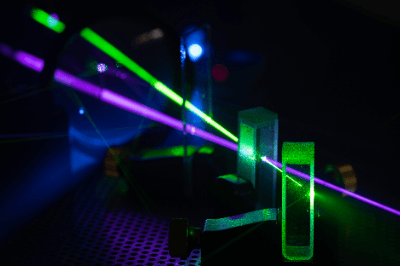What Is Time-Resolved Spectroscopy?
 In Time-Resolved spectroscopy, a chemical reaction is induced by irradiating a sample with a pulsed laser or instantaneously mixing two solution samples, and the changes resulting from the reaction are detected by emission and transmission (absorbance) spectroscopy. This technique is followed by a high-speed time-resolved measurement.
In Time-Resolved spectroscopy, a chemical reaction is induced by irradiating a sample with a pulsed laser or instantaneously mixing two solution samples, and the changes resulting from the reaction are detected by emission and transmission (absorbance) spectroscopy. This technique is followed by a high-speed time-resolved measurement.
The measurement time range varies widely depending on the reaction of interest, ranging from femtoseconds (10 to the -15th power of seconds) to seconds.
The reaction initiation method, measurement principle, and instrument configuration also vary greatly depending on the measurement time.
In addition, depending on the wavelength region (energy region) in which the emitted or transmitted light is observed, the type and usage of light sources and detectors also vary.
Therefore, Time-Resolved spectroscopy products are designed specifically for one of the time and wavelength ranges.
Uses of Time-Resolved Spectroscopy
Time-resolved spectroscopy is non-invasive because both the excitation and observation light are optical. With laser light as the light source, the light can travel a long distance. Therefore, the laser light source can be installed away from the main unit, or depending on the measurement device, a laboratory’s existing laser light source, etc., can be used.
Most commercially available products use ultraviolet or visible light as the excitation light, and ultraviolet, visible, or near-infrared light as the observation light. However, it may be possible to build a system that uses an electron beam as the excitation light or infrared or synchrotron radiation as the observation light through customization.
Features of Time-Resolved Spectroscopy
In Time-Resolved spectroscopy, the products of chemical reactions often go through transient intermediates, and the identification of these intermediates provides a correct understanding of the reaction and, in turn, guidelines for improving the molecules used in the reaction. Intermediates can be estimated and identified from transient emission and absorption spectra.
The reaction rate is not only an indicator of the group of substances whose reactivity is to be compared, but also the time order of the reaction can be used to determine the type of reaction.
For example, there are intramolecular reactions and intermolecular reactions. For intermolecular reactions, various reaction parameters such as active energy or second-order rate constant can be determined from the temperature and concentration dependence of the rate.
In addition, by analyzing the spectral changes of multiple components in detail, the reaction mechanism can also be approached.
Types of Time-Resolved Spectroscopy Products
There are several types of Time-Resolved spectroscopy products, depending on the detection method and the time region of interest.
1. Products for Luminescence Detection
When a sample emits light, the luminescence lifetime is measured because the lifetime of the luminescence indicates the physical properties of the sample.
Luminescence is broadly classified into fluorescence in the nanosecond order and phosphorescence in the microsecond and millisecond order. Since there are different measurement techniques, there are devices that can measure both and devices dedicated to one or the other.
2. Products for Transmittance Detection
For samples whose transmittance (absorbance) changes at high speed due to pulsed light irradiation, etc., transient changes in the sample can be observed by using a light source to monitor the changes.
This method of Time-Resolved spectroscopy of transmitted light is also called the transient absorption method.
The femtosecond to picosecond method is called the pump-probe method, while the method for measurements slower than nanoseconds is called the flash photolysis method.
In the pump-probe method, a delay stage creates a time difference between the excitation light and the observed light, and the observed light is measured by a slow detector.
The flash photolysis method, on the other hand, uses a continuous light source and a high-speed detector.
In recent times, the RIPT method, which links these time ranges, is also becoming popular, but it employs a unique detection method.
Since the measurement technique differs greatly depending on the time range, it is necessary to select a device according to the time range of the target reaction. In most cases, a pulsed laser is used to induce a photoreaction.
Another fast time-resolved method is the stopped-flow method, in which two solutions are mixed to initiate a reaction, and millisecond changes are observed. In this case, a special mixing device is required to complete the mixing instantaneously.
How Time-Resolved Spectroscopy Are Measured
General time-resolved measurements are macroscopic and require a uniform sample.
With luminescence lifetime devices, not only transparent solutions, but also suspended solutions, powders, and thin films can be measured as they are.
On the other hand, transient absorption systems, which measure transmitted light, generally measure transparent solutions and thin films with high transmittance. Some products can also measure shiny samples by direct reflection and powders by diffuse reflection.
Since sample temperature is also important in reaction rate measurements, a temperature-controlled unit is usually available.
Note that the presence of oxygen often affects the reaction rate and may require degassing by means of argon gas displacement or other methods.